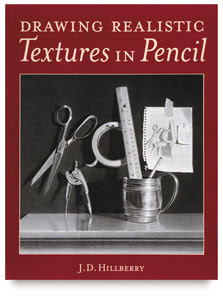 On her Making a Mark Blog, Katherine Tyrrell has invited all artists to join her October Big Drawing Book Review. I have read and done exercises from a number of art instruction books, so I thought I would join in.
On her Making a Mark Blog, Katherine Tyrrell has invited all artists to join her October Big Drawing Book Review. I have read and done exercises from a number of art instruction books, so I thought I would join in.Today I am reviewing Drawing Realistic Textures in Pencil by J.D. Hillberry, published by North Light Books in 1999 (ISBN 0-89134-868-9).
J.D. Hillberry is a self-taught artist who has discovered techniques for drawing subjects in a highly realistic way. He shares these techniques with readers in this book. Hillberry's website has examples of his work. Here is one of my drawings that utilizes his techniques.
This book will be of value to intermediate-to-advanced artists who wish to render subjects in a highly realistic manner using pencil and charcoal. I don't recommend this book for beginners, because it doesn't teach basic drawing skills.
In Chapter One, Hillberry gives a detailed explanation of the required art supplies.
In Chapter Two, Hillberry gives tips and techniques. He explains the effects that light and shadow have on form, gives tips on using value to render form, discusses blending techniques, explains how to effectively use charcoal and graphite together, and explains rubbing, indenting, and the use of frisket film.
In Chapter Three, Hillberry gives seven highly detailed step-by-step demonstrations. For example, he shows how to realistically draw glass, pitted metal, reflective metal, leather, wood, and faces. I was able to follow and apply Hillberry's step-by-step demonstrations. It tooks me a few tries to get good results, but this is because the techniques require practice, not because the instruction is poor.
In Chapter Four, Hillberry gives two more step-by-step demonstrations. One is a still life that contains a number of different textures and one is a cat on a ledge. The still life is on the cover of the book.
In order to use all of Hillberry's techniques, you will need a variety of pencils, charcoal, and miscellaneous materials such as frisket film and a chamois. You will need to make an initial investment if you don't already have a number of these items. Happily, compared to painting supplies, these materials are not expensive.
In order to get something out of any drawing book, you need to create art based on the techniques you are learning. Be forewarned that drawing in this style is very time-consuming.
I give this book 4 pencils. It does a good job at teaching what it aims to teach, for a low price. The book is attractive and the images are high-quality. Intermediate-to-advanced artists interested in creating highly realistic drawings will pick up new techniques to add to their repertoire.
I don't give the book 5 pencils because it does not meet Katherine's criterion: ... an essential book for anybody seriously interested in drawing and/or learning more about drawing. The book is not for those who are primarily interested in painterly approaches to drawing. One can create outstanding drawings without ever using the techniques discussed in this book. So I cannot say everyone needs to read this book.
3 comments:
Thanks Laurel - I'll post this in my weekly blog round-up post next Sunday.
I'm sure this is a book which quite a few people have read and will want to review so it'll be really interesting to see everybody's take on it.
Good review of the book Laurel. I have this one on backorder and it should be on its way to me very soon.
It will be interesting to go through it after reading your review.
Laurel - I've included a link to your review plus a short excerpt from it on my new squidoo lens for The Big Drawing Book Review - you can see it here
If you would prefer for it not to be included could you let me know. Thanks
Post a Comment